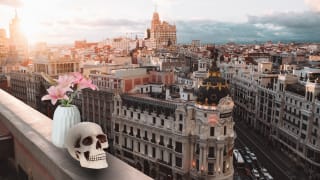The 24/7 urban revolution: How cities are transforming their night economies
By Manolis Psarros, CEO & Chief Strategist, TOPOSOPHY
When darkness falls over pretty much any large European town or city, many lights will go out, as stores close and workers head home. Yet many lights stay on, and many others appear out of the darkness, as the ‘night economy’ kicks in. Yet few other aspects of urban life have seen so many changes in recent years, as consumer behaviour has changed and pandemic impacts have taken their toll on the hospitality industry.
The ‘night economy’ is often thought of as being shorthand for ‘clubs and bars’, yet as we explore in a new report, a thriving night economy contributes so much more than places to drink and dance the night away.
So, why is the night economy important, and how is it influencing urban life in the aftermath of the pandemic? And how can cities leverage the potential of their night-time economies to foster inclusive and vibrant communities? As cities evolve post-pandemic, here at TOPOSOPHY, we’ve been exploring what cities can do to nurture thriving economies around the clock, while addressing the environmental and social challenges that this can sometimes bring.
Why the night economy matters: Understanding its impact on urban life post-pandemic
As cities emerge from the pandemic, there's a renewed focus on the night economy's role in fostering a vibrant 24-hour society. The term 'night economy' refers to a diverse range of activities taking place in town and city centres generally between the hours of 6pm and 6am. These activities can include retail, culture, leisure, transportation, and accommodation, as well as supporting services such as security and supply chains.
Despite a decline in the UK's night-time economy from 5.1% of the GDP in 2019 to 4.1% in 2022, and a corresponding drop in revenue from £116.1 billion to £93.7 billion, this sector's workforce still represents a significant portion of overall employment. In fact, in the UK, 1 in every 9 workers is part of the night-time economy (Night Time Industries Association, 2023).
Besides, the night economy also offers more than just financial benefits to urban areas. While the economics of night-time employment and consumer spending impact is often recognised, there is an increasing awareness of the need to value the cultural contributions of nighttime activities too, particularly in creative sectors such as music, cultural events and supporting sectors such as late-night public transportation and F&B. Additionally, it provides social advantages such as relaxation after a day’s work and having shops and services that offer longer opening hours can help to alleviate daytime congestion in urban spaces.
Α close look at the night-time economy
Crucially, vibrant nightlife significantly influences cities’ appeal. Around 80 cities worldwide have acknowledged this importance by forming night-time commissions and appointing leaders, dubbed 'night mayors' or 'night czars,' as seen in the Nighttime Advocacy Map, which played vital roles in supporting sectors struggling during the pandemic.
Look at major cities such as New York, London, and Sydney and the impact of the night economy becomes especially clear. New York City's night-time economy generates US$35.1 billion annually and has created 300,000 jobs. In London, the night-time economy accounts for 723,000 jobs, with a pre-Covid forecast of an additional 66,000 positions by 2026, and in Sydney, there's potential for significant growth with proper support (MIPIM World Blog).
Striking the right balance: tackling the environmental and social challenges that a thriving night economy can bring
As many local authorities are only too aware, thriving nightlife can also bring occasional environmental and community challenges. The environmental impact of increased traffic and activity during the night hours, as well as the presence of bars and clubs near residential areas (as cities become more densely populated), cannot be ignored - contributing to issues such as air and light pollution, nuisance behaviour, and litter.
Safety, crime rates, anti-social behaviour, and alcohol-related hospital admissions are also often cited as concerns and challenges, all of which put additional pressure on police and emergency services. While it is true that incidents of crime can increase with more activity during the evening and overnight hours, it is important to recognise that vibrant nightlife can also contribute to a sense of community and overall safety (contrast this with abandoned, dimly lit streets).
Our report sets out 10 key areas that local authorities need to work on in order to address safety concerns while still supporting the growth of the night economy. These include:
- Forging strategic partnerships across sectors for cohesive night economy growth and multi-stakeholder engagement.
- Attracting value creators such as innovative and creative minds to boost city appeal.
- Crafting compelling urban narratives that foster pride and diverse cultural representation.
- Activating public spaces to foster community interaction and creativity.
- Fostering community involvement in city planning for trust and collaborative growth.
- Enhancing citizen wellbeing for a happier urban life.
- Balancing resident and visitor interests for harmonious urban living.
- Understanding behavioural insights to inform strategic city planning and marketing.
- Embracing new partnership models for an integrated approach to night economy development.
- Prioritising diversity, equity, and inclusion (DEI) for a welcoming, inclusive night economy.
Elevating your city's night economy: Placemaking and marketing strategies
To create a truly thriving and sustainable nightlife culture, cities must also prioritise inclusive planning. Rather than catering to a specific demographic, it is important to consider the needs and interests of all members of the community. Indeed, nightlife and entertainment help to underpin the identity and socialisation of some communities (such as the LGBTQ community and international communities in a city), providing safe spaces for individuals to meet, and community events to take place – something which contributes to thriving, plural cities for everyone.
So, as we continue to celebrate the economic benefits of the night economy, we mustn’t forget the need for an inclusive, sophisticated, and responsible approach to supporting a 24-hour society.
Want to know more?
To learn more about how destination authorities can support the growth of their city’s night economy, download your complimentary copy of 'The 24/7 revolution: how cities are transforming their night economies' here and don’t forget to tune in to our Common Ground podcast to be part of shaping a more vibrant and inclusive nightlife.
This white paper is part of TOPOSOPHY's series, exploring key aspects of placemaking and the visitor economy, starting with the night-time economy. Keep an eye out for our upcoming publications for more in-depth analysis and insights.
TOPOSOPHY specialises in shaping places and empowering communities through strategy, research, marketing and events.









